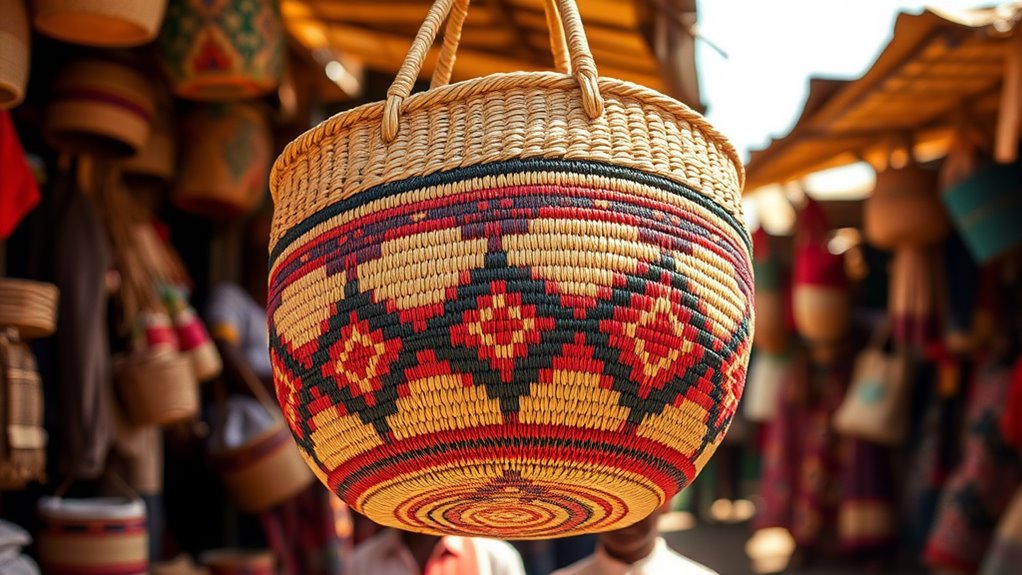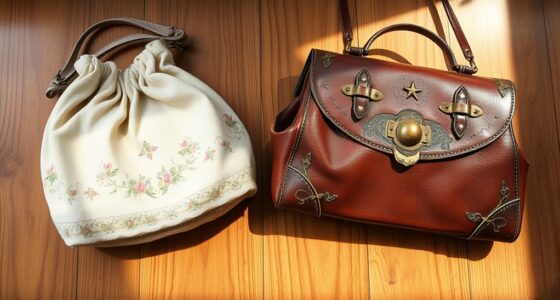The Kiondo basket bag in Kenya is a powerful symbol of cultural pride and traditional craftsmanship. It connects you to local history, community values, and regional stories told through unique patterns and natural dyes. Used in ceremonies and modern fashion alike, it supports artisans and preserves important skills. As you explore further, you’ll discover how this iconic craft continues to evolve while honoring its rich heritage.
Key Takeaways
- The kiondo basket symbolizes cultural identity, pride, and social status in Kenyan communities.
- Its intricate patterns and regional designs reflect local traditions, stories, and cultural heritage.
- Used in ceremonies and celebrations, the kiondo connects individuals to their history and shared values.
- Handmade through traditional weaving and dyeing techniques, it preserves ancestral craftsmanship.
- The kiondo promotes cultural sustainability and economic empowerment for Kenyan artisans.
Historical Roots and Traditional Craftsmanship
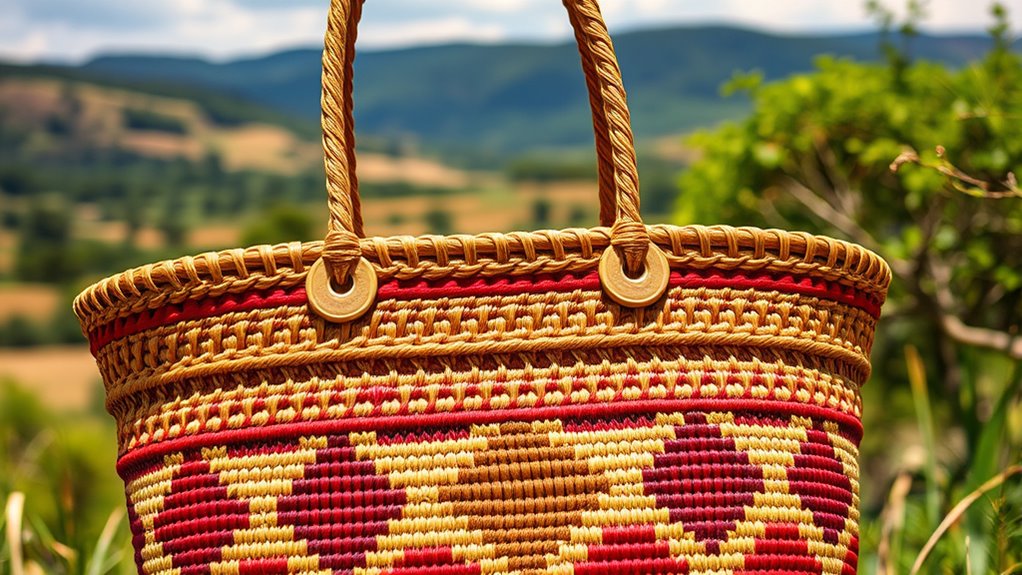
The history of the kiondo basket bag is deeply rooted in East African traditions, where craftsmanship has been passed down through generations. You’ll notice that skilled artisans use specific weaving techniques to create the basket’s sturdy structure, often employing tight, intricate patterns that guarantee durability. These techniques are complemented by traditional dyeing methods, which involve natural dyes derived from plants and minerals, giving each kiondo its unique color palette. As you observe the craftsmanship, you’ll see how artisans carefully dye the fibers before weaving, resulting in vibrant, lasting hues. This combination of weaving techniques and dyeing methods reflects a rich cultural heritage, showcasing the artisans’ expertise and dedication to preserving age-old practices that have stood the test of time. cultural heritage plays a vital role in shaping the traditional methods used in creating these iconic baskets.
Symbolism and Cultural Identity

Because the kiondo basket bag holds significant cultural meaning, it functions as a powerful symbol of identity for East African communities. You see, wearing or carrying a kiondo connects you to traditions, history, and shared values. Today’s fashion trends embrace the kiondo’s unique craftsmanship, blending tradition with modern style. Its popularity highlights a commitment to environmental sustainability, as these baskets are handmade from natural, biodegradable materials. By choosing a kiondo, you support local artisans and promote eco-friendly practices. The bag’s symbolism extends beyond aesthetics; it embodies cultural pride and resilience. As a cultural symbol, the kiondo reminds you of your roots while aligning with contemporary values of sustainability and ethical fashion. Additionally, the handmade craftsmanship involved in creating each basket ensures the preservation of traditional techniques and promotes the continuation of cultural heritage.
Regional Variations and Design Elements
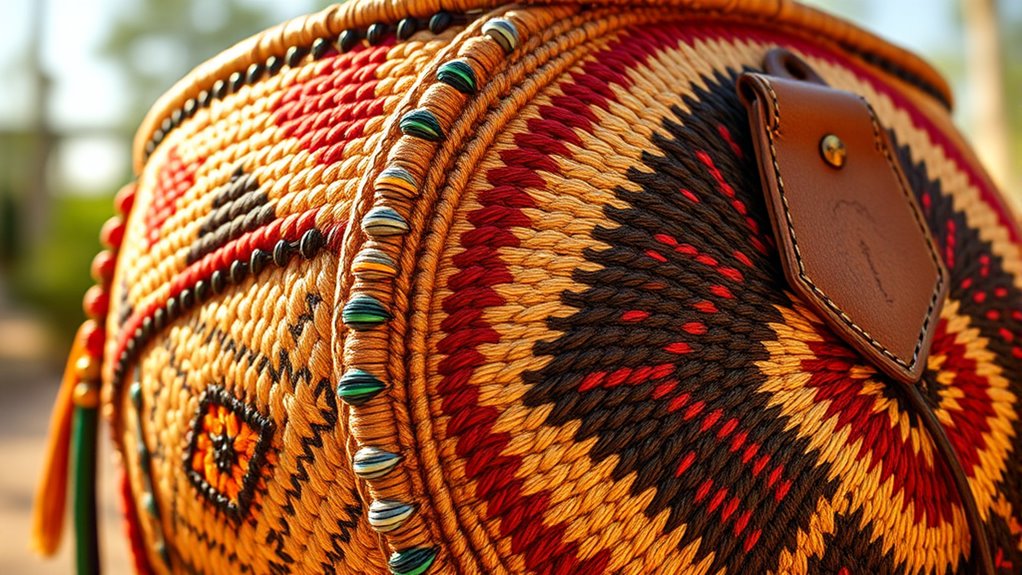
You’ll notice that regional material choices influence the look and durability of kiondo baskets, with some areas favoring specific fibers. Unique pattern designs also reflect local traditions and cultural stories, making each piece distinct. Exploring these variations reveals how craftsmanship connects to regional identity and history. Additionally, understanding the design elements involved can deepen appreciation for the cultural significance behind each basket.
Regional Material Choices
Regional variations considerably influence the materials used in crafting kiondo basket bags, reflecting local resources and cultural preferences. In some areas, artisans incorporate traditional natural fibers like sisal, palm leaves, or goat hide, showcasing indigenous craftsmanship. However, in regions with access to synthetic fibers, you might notice the use of these materials to produce more durable or affordable bags. Synthetic fibers are especially popular due to their resistance to weather and pests, making them suitable for mass production. While natural materials preserve cultural authenticity, the adoption of synthetic options allows for larger-scale manufacturing, increasing accessibility. Additionally, regional variations in material choices often correlate with local resource availability, further shaping the look and feel of each basket, highlighting the blend of tradition and modern influences in Kenyan craftsmanship.
Unique Pattern Designs
Have you ever noticed how the patterns on kiondo baskets vary across different regions? These weaving patterns reflect regional identities and cultural stories. Each area uses specific techniques to create unique geometric or symbolic designs. For example, some regions favor bold, repetitive motifs, while others incorporate intricate, detailed patterns. Color symbolism also plays a crucial role; bright colors like red may symbolize fertility or vitality, while darker hues can represent protection or tradition. The combination of weaving patterns and colors makes each basket a storytelling piece, showcasing the weaver’s heritage and personal expression. By observing these design elements, you gain insight into the community’s values and history, making the kiondo not just a practical item but a meaningful cultural artifact. Additionally, vetted design elements ensure the baskets are both culturally significant and durable, highlighting the skill and tradition involved in their craft.
The Role of Kiondo in Kenyan Ceremonies and Celebrations

Kiondo baskets play a vital role in Kenyan ceremonies and celebrations, symbolizing cultural identity and social status. During weddings, elders, and community gatherings, they’re often used to carry gifts, food, or offerings, highlighting tradition. Today, fashion trends incorporate kiondo bags as statement accessories, blending heritage with modern style. This trend helps promote sustainable sourcing, ensuring artisans craft authentic baskets using eco-friendly materials. When you see kiondo in these events, you witness more than a functional item; it’s a symbol of heritage and pride. As they gain popularity in contemporary fashion, they continue to reinforce cultural values while adapting to current trends, making them essential in both traditional and modern Kenyan celebrations. Additionally, the WWE Raw’s Financial Impact demonstrates how entertainment items like traditional crafts can also influence cultural pride and economic growth.
Economic Impact on Local Artisans and Communities
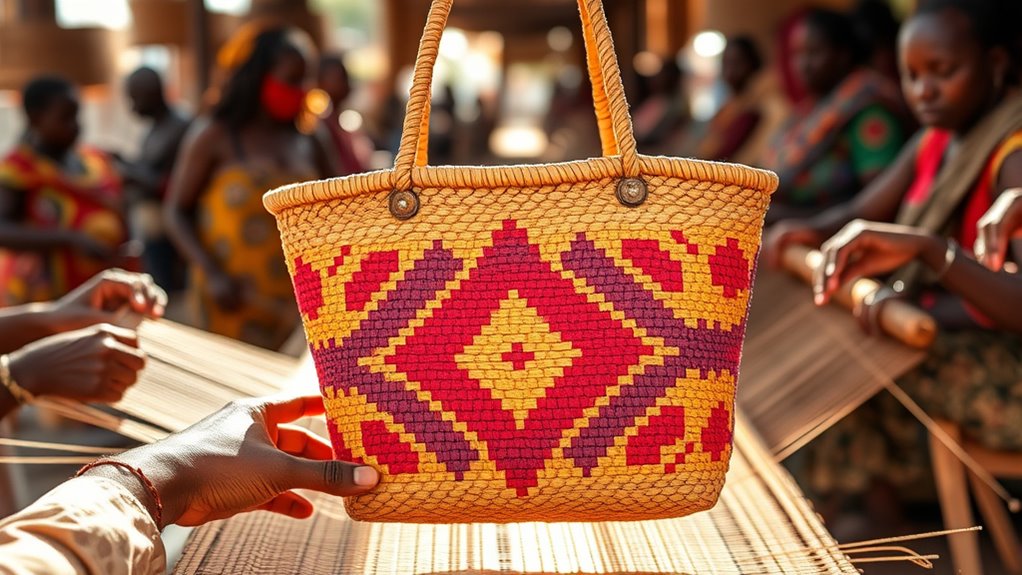
You can see how crafting kiondo baskets boosts local artisans’ incomes and supports their families. These artisans preserve traditional techniques, ensuring their cultural heritage stays alive. By purchasing these baskets, you’re helping strengthen entire communities economically and culturally. Additionally, promoting awareness of cultural significance helps sustain the traditions behind the craft for future generations.
Livelihood Enhancement
The craftsmanship involved in creating kiondo baskets provides essential economic opportunities for local artisans and their communities. By integrating traditional skills with modern fashion trends, artisans find new markets and expand their customer base. Kiondo baskets, once primarily tourist souvenirs, now appear in high-end boutiques and fashion shows, boosting demand. This increased interest helps artisans earn a sustainable income and improve their livelihoods. The sales of these baskets support families, fund community projects, and incentivize the preservation of traditional weaving techniques. As a result, the economic benefits extend beyond individual artisans, strengthening entire communities. The popularity of kiondo baskets in modern fashion highlights their value, ensuring that craftsmanship continues to thrive while providing crucial livelihood enhancement opportunities. Additionally, the use of traditional weaving techniques ensures the preservation of cultural heritage while adapting to contemporary markets.
Cultural Preservation
As communities continue to produce and sell kiondo baskets, they actively preserve their cultural heritage and traditional craftsmanship. This not only keeps age-old weaving techniques alive but also promotes their significance in urban fashion and international exports. By valuing these baskets, you help sustain local artisans’ skills and ensure their stories are shared globally. The export of kiondo baskets introduces their cultural meaning to new audiences, strengthening community identity. Supporting artisans directly conserves traditional methods, and promoting kiondo in international markets boosts cultural awareness. Encouraging local craftsmanship safeguards cultural diversity. Additionally, integrating authentic craftsmanship into modern designs helps maintain the integrity and uniqueness of this traditional art form. Through these efforts, you contribute to a vibrant cultural legacy that continues to thrive amidst modern influences, ensuring that the art of basket weaving remains an integral part of Kenya’s cultural fabric.
The Kiondo as a Modern Cultural Icon
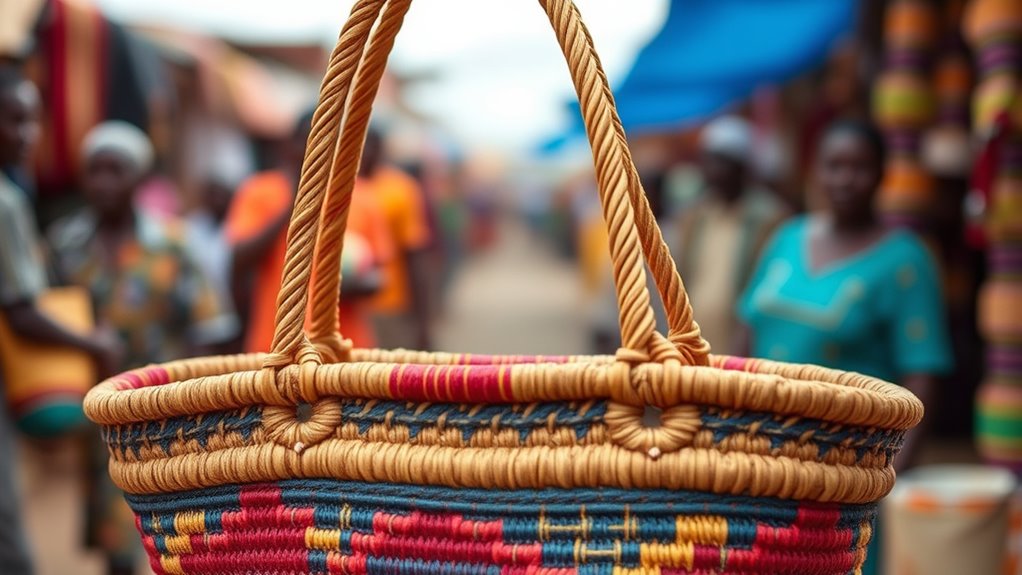
Among Kenya’s vibrant craft traditions, the kiondo has emerged as a powerful symbol of cultural identity and pride. Today, it’s recognized as a modern cultural icon, blending tradition with fashion innovation. Designers incorporate kiondo patterns into contemporary accessories, showcasing Kenya’s rich craftsmanship worldwide. This evolution helps preserve the craft while appealing to global markets, emphasizing environmental sustainability by promoting handmade, eco-friendly products. As a versatile statement piece, the kiondo transcends its traditional roots, inspiring new generations to celebrate their heritage through innovative designs. Its popularity in fashion circles highlights how cultural symbols can adapt to modern trends without losing their authenticity. Promoting biodiversity in craft materials can further enhance sustainability and environmental conservation efforts. You become part of a movement that values sustainability and cultural expression, making the kiondo a true symbol of Kenya’s evolving identity.
Challenges in Preserving Traditional Weaving Techniques
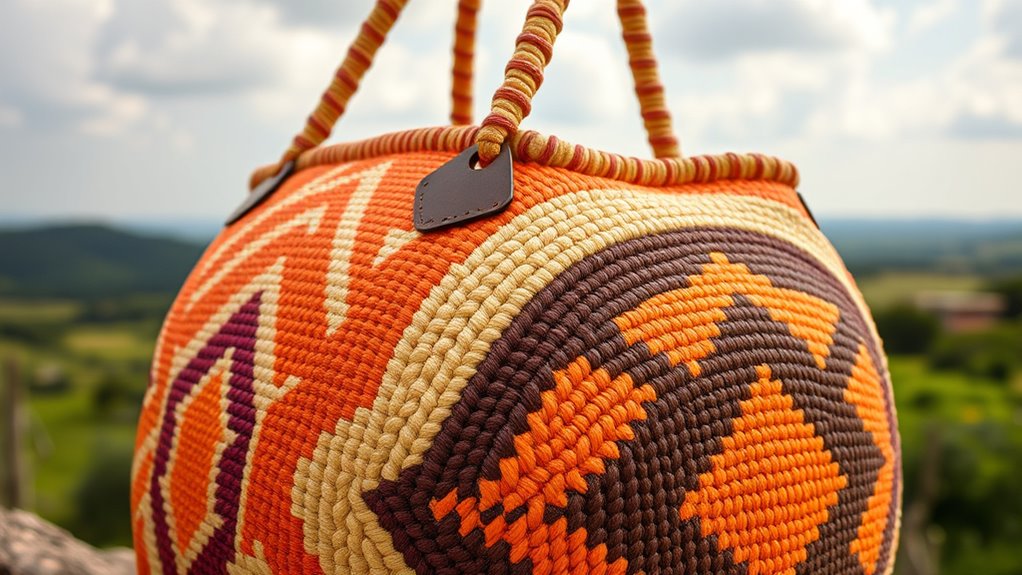
Preserving traditional weaving techniques faces significant hurdles as modernization and globalization continue to influence local communities. You may notice that many artisans are switching to synthetic materials, which are cheaper and easier to find. This shift impacts the authenticity and durability of traditional kiondo baskets. Mass production also plays a role, as large factories prioritize speed over craftsmanship, diluting the cultural value. Key challenges include:
Traditional weaving faces threats from synthetic materials and mass production, risking the loss of cultural craftsmanship.
- The availability of synthetic materials replacing natural fibers
- The decline of skilled artisans due to economic pressures
- The spread of mass-produced alternatives, reducing demand for handcrafted baskets
These factors threaten the survival of authentic weaving techniques, risking their disappearance as cultural symbols. To preserve this heritage, efforts must focus on supporting traditional artisans and promoting their craftsmanship.
The Future of Kiondo Craftsmanship in a Globalized World
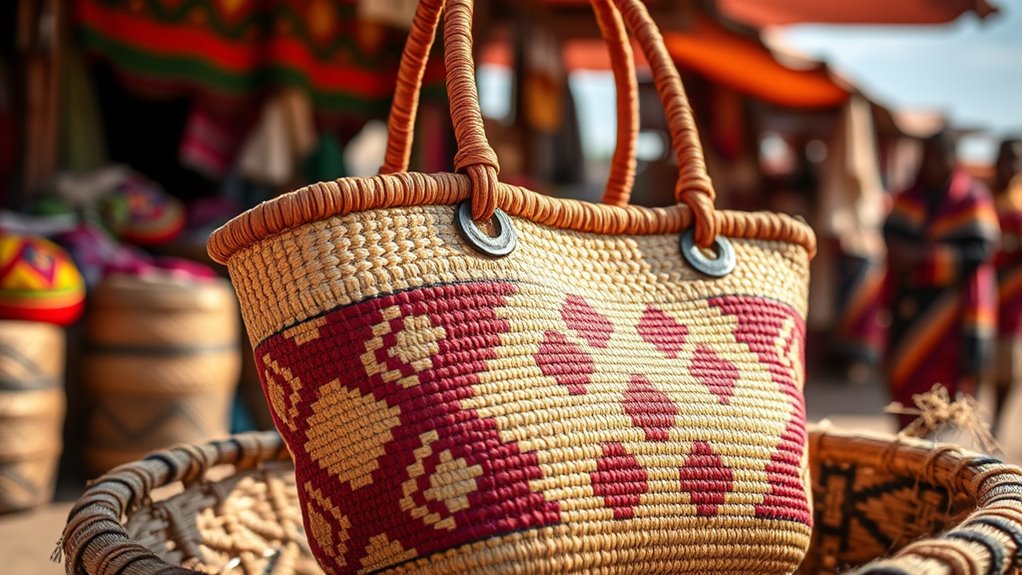
The future of kiondo craftsmanship depends on how communities and artisans adapt to the pressures of globalization. Digital globalization offers opportunities to showcase traditional skills globally, especially through social media and e-commerce. The fashion industry increasingly incorporates handmade accessories, making kiondo bags appealing to international markets. To stay relevant, you must blend tradition with modern trends. Consider this table:
| Strategy | Benefit | Challenge |
|---|---|---|
| Digital marketing | Reaches wider audiences | Maintaining authenticity |
| Collaboration with designers | Elevates style and appeal | Balancing tradition and innovation |
| Export partnerships | Increases sales and exposure | Navigating regulations |
| Incorporation of new materials | Attracts trendy consumers | Preserving craftsmanship |
| Training youth | Ensures future artisans | Passing down skills |
Frequently Asked Questions
How Is the Kiondo Adapted for Contemporary Fashion Trends?
You’ll find that Kiondo styling now embraces fashion fusion, blending traditional craftsmanship with modern trends. Designers incorporate vibrant colors, unique patterns, and sleek shapes, making the Kiondo adaptable for everyday wear or special occasions. By pairing it with contemporary outfits, you create a bold statement that honors heritage while staying trendy. This evolution of the Kiondo highlights its versatility, allowing you to showcase cultural pride with a fashionable twist.
What Materials Are Most Commonly Used in Modern Kiondo Production?
You’ll find that modern kiondo baskets often combine traditional materials like sisal or palm leaves with synthetic fibers, making them more durable and versatile. Makers now use innovative recycling techniques to incorporate plastic and other recycled materials, reducing waste and enhancing sustainability. These adaptations help the kiondo stay relevant in contemporary fashion, appealing to eco-conscious consumers while preserving its cultural essence.
Are There Any Notable Kenyan Designers Incorporating Kiondo Into Their Collections?
You’ll find that Kenyan designers increasingly incorporate kiondo into their collections, highlighting its cultural symbolism. These designers often collaborate with local artisans, preserving traditional craft techniques while modernizing the designs. By doing so, they showcase the kiondo’s rich heritage and elevate its status as a stylish accessory. Such artisan collaborations help sustain cultural practices and inspire a broader appreciation for the kiondo’s significance beyond Kenya.
How Do Different Kenyan Communities Perceive the Wearing of Kiondo Today?
You’ll find that perceptions of wearing the kiondo today vary across Kenyan communities. Many see it as a symbol of cultural identity and traditional craftsmanship, proud to showcase their heritage. Others view it as a fashionable accessory, blending tradition with modern style. Overall, wearing a kiondo helps you connect to your roots, celebrating Kenyan culture while embracing contemporary trends. It’s a meaningful way to honor tradition in everyday life.
What Initiatives Exist to Promote Sustainable Kiondo Craftsmanship?
Like a beacon guiding tradition through modern times, initiatives now focus on promoting sustainable kiondo craftsmanship. You can support artisan training programs that preserve weaving techniques, ensuring skills aren’t lost to time. Export initiatives open new markets, empowering artisans economically while sharing Kenya’s rich culture globally. By backing these efforts, you help keep the spirit of the kiondo alive, weaving sustainability and cultural pride into every basket.
Conclusion
As you admire the vibrant kiondo, remember it’s more than just a bag—it’s a tapestry of Kenyan heritage, woven with tradition and pride. While globalization pushes traditional crafts to the edge, these baskets remain a colorful symbol of identity and resilience. Embrace the beauty of this ancient art, knowing that each stitch connects you to generations past, even as modern trends threaten to overshadow their legacy.
